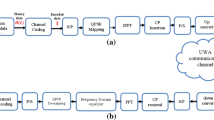Abstract
This paper compares the effectiveness of different spread OFDM techniques with transmit diversity used for underwater acoustic communications. Spreading by Walsh-Hadamard codes, discrete Fourier transform, discrete cosine transform and carrier interferometry (CI) codes have been combined with the application of space-time and space-frequency transmit diversity in OFDM for underwater acoustic communication. The spreading technique helps overcome frequency-selective and multipath fading and also provides reduced peak-to-average power ratio (PAPR). The application of space time and space frequency coding techniques improves the data rate and reliability of the spread OFDM scheme in terms of bit error rate (BER). Simulation results show that all the spread OFDM schemes show better BER performance in underwater environment when transmit diversity schemes are used. CI spread OFDM with space-frequency block coding shows a BER of \(1\times 10^{-6}\) at a signal-to-noise ratio (SNR) of \(13.6\) dB and is proposed as one of the best scheme. This gain in SNR may be used to further increase the data transmission rate.












Similar content being viewed by others
References
Ahmed, N., Natarajan, T., & Rao, K. R. (1974). Discrete cosine transform. IEEE Transactions on Computers, C–23(1), 90–93.
Al-Mahmoud, M., & Zoltowski, M.D. (2009). Performance evaluation of code-spread OFDM using vandermonde spreading. In IEEE radio and wireless symposium, pp. 320–323.
Alamouti, S. (1998). A simple transmit diversity technique for wireless communications. IEEE Journal on Selected Areas in Communications, 16(8), 1451–1458.
Dlugaszewski, Z., & Wesolowski, K. (2000). WHT/OFDM—an improved OFDM transmission method for selective fading channels. In symposium on communications and vehicular technology, 2000. SCVT-200, pp. 144–149.
Domingo, M. C. (2008). Overview of channel models for underwater wireless communication networks. Physical Communication, 1(3), 163–182.
Han, S. H., & Lee, J. H. (2005). An overview of peak-to-average power ratio reduction techniques for multicarrier transmission. IEEE Wireless Communications, 12(2), 56–65.
Kumar, P., & Kumar, P. (2012). Performance evaluation of DFT-spread OFDM and DCT-spread OFDM for underwater acoustic communication. In IEEE vehicular technology conference (VTC fall), (pp. 1–5).
Kumar, P., & Kumar, P. (2013). Performance evaluation of modified OFDM for underwater communications. In IEEE international conference on communications 2013: IEEE ICC’13—workshop on radar and sonar networks (pp. 977–981). Budapest: Hungary.
Mukherjee, M., & Kumar, P. (2011). Overloaded WH-spread CI/MC-CDMA with iterative interference cancellation. IEEE Communications Letters, 15(12), 1391–1393.
Otnes, R., Asterjadhi, A., Casari, P., Goetz, M., Husy, T., Nissen, I., et al. (2012). Underwater acoustic networking techniques. Briefs in electrical and computer engineering. New York: Springer.
Proakis, J. G., Sozer, E. M., Rice, J. A., & Stojanovic, M. (2001). Shallow water acoustic networks. IEEE Communications Magazine, 39(11), 114–119.
Shanlin, S., Chunping, H., Lei, Y., & Jinlin, F. (2008). A novel method based DCT to reduce PAPR of OFDM systems. In 4th International conference on wireless communications, networking and mobile computing, 2008. WiCOM ’08, (pp. 1–5).
Stojanovic, M., & Preisig, J. (2009). Underwater acoustic communication channels: Propagation models and statistical characterization. IEEE Communications Magazine, 47(1), 84–89.
Wiegandt, D.A., Nassar, C.R., & Wu, Z. (2004). The elimination of peak-to-average power ratio concerns in OFDM via carrier interferometry spreading codes: A multiple constellation analysis. In proceedings of the thirty-sixth southeastern symposium on system theory, (pp. 323–327).
Xu, F., Hu, X., & Xu, R. (2007). A novel implementation of carrier interferometry OFDM in an underwater acoustic channel. In IEEE OCEANS—Europe, (pp. 1–5).
Yonghuai, Z., Haixin, S., En, C., & Weijie, S. (2010). An underwater acoustic implementation of DFT-spread OFDM. EURASIP Journal on Advances in Signal Processing, 2010(7), 1–7.
Zielinski, A., Yoon, Y. H., & Wu, L. (1995). Performance analysis of digital acoustic communication in a shallow water channel. IEEE Journal of Oceanic Engineering, 20(4), 293–299.
Author information
Authors and Affiliations
Corresponding author
Rights and permissions
About this article
Cite this article
Kumar, P., Kumar, P. A Comparative Study of Spread OFDM with Transmit Diversity for Underwater Acoustic Communications. Wireless Pers Commun 83, 69–86 (2015). https://doi.org/10.1007/s11277-015-2380-8
Published:
Issue Date:
DOI: https://doi.org/10.1007/s11277-015-2380-8




